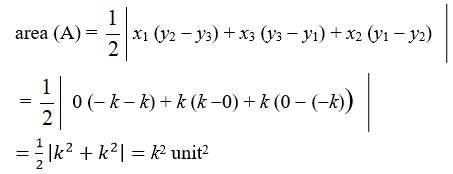Maths
Get insights from 6.5k questions on Maths, answered by students, alumni, and experts. You may also ask and answer any question you like about Maths
Follow Ask QuestionQuestions
Discussions
Active Users
Followers
New answer posted
6 months agoContributor-Level 10
S = {a, b, c}, T = {1, 2, 3}
(i) F: S → T is defined as:
F = { (a, 3), (b, 2), (c, 1)}
⇒ F (a) = 3, F (b) = 2, F (c) = 1
Therefore, F−1 : T → S is given by
F−1 = { (3, a), (2, b), (1, c)}.
(ii) F: S → T is defined as:
F = { (a, 2), (b, 1), (c, 1)}
Since F (b) = F (c) = 1, F is not one-one.
Hence, F is not invertible i.e., F−1 does not exist.
New answer posted
6 months agoContributor-Level 10
Onto functions from the set {1, 2, 3, …, n} to itself is simply a permutation on n symbols 1, 2, …, n.
Thus, the total number of onto maps from {1, 2, …, n} to itself is the same as the total number of permutations on n symbols 1, 2, …, n, which is n!
New answer posted
6 months agoContributor-Level 10
28. Given, f (x)= ![]()
The given fxn is valid for all x such that x – 1 ≥ 0 ⇒x≥ 1
∴ Domain of f (x)= [1,∞)
As x ≥ 1
⇒ x – 1 ≥ 1 – 1
⇒ x – 1 ≥ 0
⇒ ≥ 0
⇒ f (x) ≥ 0
So, range of f (x)= [0,∞ )
New answer posted
6 months agoContributor-Level 10
Let S be a non-empty set and P (S) be its power set. Let any two subsets A and B of S.
It is given that: is defined as
We know that
Thus, X is the identity element for the given binary operation*.
Now, an element is invertible if there exists such that
(As X is the identity element)
i.e.
This case is possible only when
Thus, X is the only invertible element in P (X) with respect to the given operation*.
Hence, the given result is proved.
New answer posted
6 months agoContributor-Level 10
Since every set is a subset of itself, ARA for all A ∈ P (X).
∴R is reflexive.
Let ARB ⇒ A ⊂ B.
This cannot be implied to B ⊂ A.
For instance, if A = {1, 2} and B = {1, 2, 3}, then it cannot be implied that B is related to A.
∴ R is not symmetric.
Further, if ARB and BRC, then A ⊂ B and B ⊂ C.
⇒ A ⊂ C
⇒ ARC
∴ R is transitive.
Hence, R is not an equivalence relation since it is not symmetric.
New answer posted
6 months agoContributor-Level 10
62.
The given eqn of the lines are
y - x = 0 _____ (1)
x + y = 0 ______ (2)
x - k = 0 ______ (3)
The point of intersection of (1) and (2) is given by
(y - x) - (x + y) = 0
⇒ y - x -x -y = 0
y = 0 and x = 0
ie, (0, 0)
The point of intersection of (2) and (3) is given by
(x + y) – (x – k) = 0
y + k = 0
y = –k and x = k
i.e, (k, –k)
The point of intersection of (3) and (1) is given by
x = k
and y = k
ie, (k, k).
Hence area of triangle whose vertex are (0, 0), (k, –k)
and (k, k) is

New answer posted
6 months agoContributor-Level 10
Define by
And, by,
We first show that g is not onto.
For this, consider element 1 in co-domain N. it is clear that this element is not an image of any of the elements in domain.
is not onto.
Now, is defined by,
Then, it is clear that for , there exists such that
Hence, gof is onto.
New answer posted
6 months agoContributor-Level 10
27. Given, f (x)=
The given function is valid if denominator is not zero.
So, if x2 – 8x+12=0.
⇒ x2 – 2x – 6x+12=0
⇒ x (x – 2) –6 (x – 2)=0
⇒ (x – 2) (x – 6)=0
⇒ x=2 and x=6.
So, f (x) will be valid for all real number x except x=2,6.
∴ Domain of f (x)=R – {2,6}
New answer posted
6 months agoContributor-Level 10
Define as and as
We first show that g is not injective.
It can be observed that:
is not injective.
Now, is defined as
Let such that
Since , both are positive.
Hence, gof is injective
New answer posted
6 months agoContributor-Level 10
61. The given Eqn of the line is = 1 ______ (1)
so, Slope of line = -
The line ⊥ to line (1) say l2 has
Slope of l2 =
Let P (0, y) be the point of on y-axis where it is cut by the line (1)
Then,
y = 6
i.e, the point P has co-ordinate (0, 6)
Eqn of line ⊥ to and cuts y-axis at P (0,6) is
y – 6 = (x – 0)
3y – 18 = 2x
2x – 3y + 18 = 0
Taking an Exam? Selecting a College?
Get authentic answers from experts, students and alumni that you won't find anywhere else
Sign Up on ShikshaOn Shiksha, get access to
- 65k Colleges
- 1.2k Exams
- 679k Reviews
- 1800k Answers
